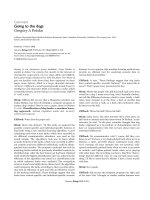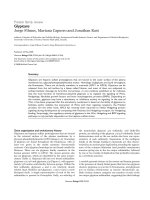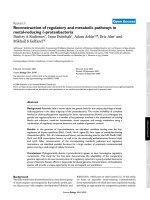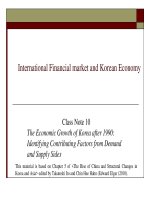the economic growth of korea after 1990 identifying contributing factors from demand and supply sides
Bạn đang xem bản rút gọn của tài liệu. Xem và tải ngay bản đầy đủ của tài liệu tại đây (282.91 KB, 35 trang )
International Financial market and Korean Economy
Class Note 10
The Economic Growth of Korea after 1990:
Identifying Contributing Factors from Demand
and Supply Sides
This material is based on Chapter 5 of
Introduction(1/2)
The Purpose of This Study is
To understand the Growth of Korean Economy since
1990
• Based on two linear stochastic models, which
contrast the institutional changes Korea went
through after the Financial Crisis
• To measure the relative contributions of various
shocks to the growth path of Korea
• Demand, supply (productivity), oil shocks,…
Introduction(2/2)
Methodology
Introduce two systems of linear stochastic difference
equations, each of which represents the Korean
economy before and after the Financial Crisis.
Following Blanchard and Quah(1989), (1) Derive longrun restrictions and (2) Estimate SVAR models with
them.
Shocks are roughly classified into demand, supply and
foreign shocks.
Observations(1/2)
Real GDP Growth(1971.1/4~2007.2/4)
(Quarterly, Year-on-Year, %)
1971~1979
1980~1989
1990~1999
2000~2007.2/4
total
Average
8.1
7.4
6.0
5.0
6.7
St.Dev
3.4
3.8
4.8
2.1
3.9
• Speed
of Growth is decelerating.
“ Is it a ominous sign of Slowdown? Or Are we there
yet?”
Observations(2/2)
Real GDP Growth
(Year-on-Year % Change, Yearly Growth Rate, %)
35
30
25
20
15
10
5
0
-5
-10
-15
-20
-25
-30
-35
-40
1971
1974
1977
1980
1983
1986
1989
1992
1995
lrGDP
Institutional Changes after the Currency Crisis
• Restructuring in Financial Sectors
• Inflation Targeting
• A Floating Exchange Rate System
1998
2001
lrGDP(s.a)
2004
2007
Discussions
Shim(2001)
•Assuming a closed economy
•Shocks are arranged so as to have a lower triangular covariance
matrix.
Kim(2005)
•Analyzing the impact of foreign shocks on domestic economy.
Oh(2007)
•An open economy version of B-Q(1989), consisting of Import
Volume, GDP and CPI.
Limitations
•Not based on economic models
•Doesn’t consider the institutional changes after the Crisis.
Sources of Shocks and Transmission Channels(1/2)
Demand Shocks
•(Domestic) Idiosyncrasies in Consumption,
Investment, Fiscal Stance and FX Market
•(Foreign) TOT , the world economic growth
•Supply Shocks
•(Domestic) Changes Factor Productivities and TFP
•(Foreign) Changes in the Prices of Raw Materials
including Oil and Technological Progress
Sources of Shocks and Transmission Channels(2/2)
Changes of the Economic Environments
•(Domestic) Restructured financial market, inflation
targeting, and flexible exchange rate
•(Foreign) Global phenomena of low interest rate and
housing price hike, and the emergence of China as a
world economic power
Estimated Equations and Identifications(1/8)
Backbone
•Blanchard and Quah(1989)
•Stock and Watson(2002)
•With an additional assumption of “A small open
economy”.
Estimated Equations and Identifications(2/8)
A. Inflation Targeting and Flexible Exchange Rate
• Modified from Stock and Watson(2002)
• A monetary authority follows a Taylor rule.
• A small open economy: TOT and Exchange rate
Estimated Equations and Identifications(3/8)
A. Inflation Targeting and Flexible Exchange Rate
(1) IS curve
yt = κrt − qt + θ ty , θ ty = θ ty−1 + ε ty ,
1 k
rt = Rt − ∑ Et [π t + j ] , qt = pt − (et + ptf )
k j =1
(2) New Keynesian Phillips curve (Aggregate supply curve)
∞
π t = γ ∑ δ i Et [ ytp+i − yt +i ] + ε tπ
i =0
(3) Forward looking Taylorh rule
rt = β π Et [π t + h ] + β y ∑ Et [ y tp+i − y t +i ]
j =1
(4) An equilibrium condition of the FX market
Rt = Rt f + Et [et +1 − et ]
Estimated Equations and Identifications(4/8)
(5) Derive
a SVMAR system, which represents macro
variables ( ∆y t , π t , Rt , ∆et ) as functions of exogenous
shocks ( ε ty , ε ty , ε tπ , ε te)
p
ety
∆y t
ety
πt
R = A( L) e π
t
t
∆e
ee
t
t
p
1
0
+
0
0
− 1
0 π t f
f
0 Rt
− 1
ety− j 1
y
∞
e 0
= ∑ A j tπ− j +
j = 0 et − j 0
e e 0
t− j
p
− 1
0 π t f
f
0 Rt
− 1
• Productivity shock( ε y )
p
NA NA NA NA
∞
NA NA NA 0
A∞ ≡ A(1) = ∑ A j =
NA NA 0 0
j =0
NA 0 0 0
t
-(P) real GDP, price and exchange rate, (T) interest rate
• Demand shock( ε ty ), Price Shock( ε tπ )
-(P) real GDP, Price, (T) interest and exchange rate
• Exchange rate shock( ε e )
t
-(P) real GDP, (T) price, interest and exchange rate
Estimated Equations and Identifications(5/8)
B. Aggregate Targeting and Fixed Exchange Rate
• The monetary authority controls the Quantity of
Money
• By adjusting Money Growth
• Assuming a fixed or managed exchange rate system,
• Autonomy of monetary policy is tied to maintain
0 interest rate differential with a foreign country.
• The model describes Korea before the financial crisis.
Estimated Equations and Identifications(6/8)
B. Aggregate Targeting and Fixed Exchange Rate
(1) Aggregate demand curve (a combination of IS and LM)
κ
yt =
b
( mt − p t ) −
κ
k
(1 +
k
∑ E [π
j =1
t
t+ j
] − qt
aκ
)
b
+ θt , θt ≡
y
θ tIS
y
1+
aκ
b
= θ ty−1 + ε ty
(2) New Keynesian Phillips curve (Aggregate supply curve)
∞
π t = γ ∑ δ i Et [ ytp+i − yt +i ] + ε tπ
i =0
(3) An equilibrium condition of the FX market
Rt = Rt f , et = e , Rt f = S f , R X t f
(4) Money supply
mt = yt + bRt f + pt
Estimated Equations and Identifications(7/8)
(5)
Derive a SVMAR system, which represents macro
variables ( ∆yt , π t , Rt , ∆mt , π t f ) as functions of
exogenous shocks (ε ty , ε ty , ε tπ , ε t f , x , ε t f ,π )
p
p
ety− j
ety
∆yt
y
y
et − j
et ∞
πt
π
R = A( L) π =
A
e
j et − j
t ∑
t
etf , x j =0 etf−, jx
∆mt
f ,π
f ,π
πf
t
et
et − j
p
NA NA NA NA NA
NA
NA
NA
0
0
∞
A∞ ≡ A(1) = ∑ A j = 0
0 NA NA 0
j =0
NA
NA
NA
0
0
0
0
0 NA NA
• Singularity arises in the longrun response matrix of A∞ .
• Decrease the numbers of shocks
and variables.
Estimated Equations and Identifications(8/8)
(6) Rearrange with three variables
2
• To handle with over-identification, run the log-likelihood χ-test
additionally
y
f
f
∆yt ∞ et − j π t + κ ∆Rt
y
0
Rt = ∑ A j et − j +
∆m j =0 eπ π f + (κ + b) ∆R f
t
t
t− j t
p
ety− j
υ1
∞ y
f
≈ ∑ A j et − j + π t υ 2
j =0 eπ
υ
−
t
j
3
p
• Productivity shock(ε ty )
p
NA NA NA
A∞ = 0
0 NA
0 NA 0
-(P) real GDP, (T) interest rate and money
• Demand shock( ε ty )
- (P) real GDP and Money, (T) interest rate
π
• Price shock(ε t )
- (P) real GDP, (T) interest rate and money
The Descriptions of the Data (1/3)
Time Coverage and Notable Features
• Source : BOK
• Real GDP, Price, Exchange Rate (US $/KOR W) , Money :
1970.1/4~2007.2/4
• The yield of 1 year Government Bond : 2000.1/4~2007.2/4
• 3 month CD (91 days) Rate: 1991.1/4~2007.2/4
• Has a longer series than that of 1 year Government Bond
but is not a proper representative interest rate.
• Call rate ( a cousin of FFR in Korea) is not used for the
frequency mismatch.
• M2 for the Monetary Aggregate
The Descriptions of the Data (2/3)
Unit Root Test Results(DF-GLS)
Test statistic
(DF-GLS)
1% level
5% level
10% level
Growth rate of real GDP
-2.661
-2.581
-1.943
-1.615
Inflation(GDP deflator)
-2.712
-2.581
-1.943
-1.615
Nominal interest rate
(TB 1-year)
-1.365
(-4.395)
-2.647
(-2.650)
-1.953
(-1.953)
-1.610
(-1.610)
Nominal interest rate
(CD 91 days)
-0.722
(-5.278)
-2.602
(-2.602)
-1.946
(-1.613)
-1.613
(-1.613)
Change rate of exchange
rate(₩/US$)
-6.068
-2.599
-1.946
-1.614
Growth rate of monetary
aggregate(M2)
-1.352
(-2.410)
-2.581
(-2.581)
-1.943
(-1.943)
-1.615
(-1.615)
Unemployment rate
2.659
-2.581
-1.943
-1.615
Note: ( ) is a result of the first order difference.
The Descriptions of the Data (3/3)
Lag Order Selection Criteria for S-W Model
Periods
Variables
LR
FPE
AIC
HQIC
SBIC
2000.1/4
~2007.2/4
Growth rate of real GDP
Inflation
Interest rate(3-month TB)
Unemployment rate
Change rate of exchange rate
1
-
5
5
5
1991.1/4
~1997.3/4
Growth rate of real GDP
Inflation
Interest rate(3-month CD)
Growth rate of monetary
aggregate
2
1
19
19
19
IR and FEVD Analysis (1/14)
The estimation results are displayed:
Impulse Response analysis
Forecasting Error Variance Decomposition
IR Analysis (2/14)
A. Inflation Targeting and Flexible Exchange Rate
• 2000.1/4~2007.2/4
Real GDP
Price index
Interest rate
Exchange rate
Note: Each of shock 1,2,3,4 represents a shock from productivity, or aggregate demand, or price, or exchange rate.
FEVD Analysis (3/14)
A. Inflation Targeting and Flexible Exchange Rate
• 2000.1/4~2007.2/4
Growth rate of real GDP
shock 1
shock 2
shock 3
shock 4
Interest Rate
shock 1
shock 2
shock 3
Inflation
shock 1
shock 2
shock 3
shock 4
Volatility of the exchange rate
shock 4
shock 1
shock 2
shock 3
shock 4
Note: Each of shock 1,2,3,4 represents a shock from productivity, or aggregate demand, or price, or exchange rate.
IR and FEVD Analysis (4/14)
B. Aggregate Targeting and Fixed Exchange Rate
(1991.1/4~1997.3/4)
<Impulse Response>
<FEVD>
Real GDP
Changes in
growth rate of real GDP
shock 1
shock 2
shock 3
Interest rate
Monetary aggregate
Changes in
interest rate
Changes in
monetary aggregate
shock 1
shock 2
shock 3
shock 1
shock 2
Note: Each of shock 1,2,3 represents a shock from productivity, or aggregate demand, or price.
shock 3
IR and FEVD Analysis(5/14)
C. B-Q(1989)’s Original Model (2-variables and 2-shocks)
(1970.1/4~2007.2/4)
<Impulse Response> Growth rate of real GDP
<FEVD>
Changes in growth rate of real GDP
shock 1
shock 2
Unemployment rate
Changes in unemployment rate
shock 1
shock 2
Note: Each of shock 1,2 represents a shock from demand side or supply side.
IR and FEVD Analysis(6/14)
C. B-Q(1989)’s Original Model (2-variables and 2-shocks)
(1970.1/4~1979.4/4)
<Impulse Response> Growth rate of real GDP
<FEVD>
Changes in growth rate of real GDP
shock 1
shock 2
Unemployment rate
Changes in unemployment rate
shock 1
shock 2
Note: Each of shock 1,2 represents a shock from demand side or supply









